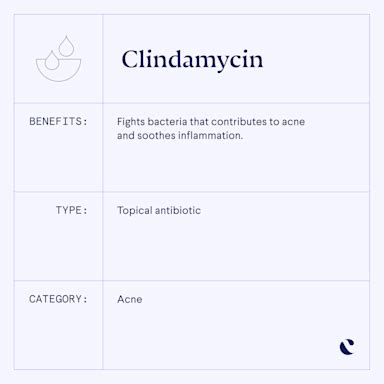Intro
Discover Clindamycin side effects, including antibiotic resistance, skin reactions, and gastrointestinal issues, to ensure safe usage and minimize adverse reactions, interactions, and allergic responses.
The use of antibiotics has become a cornerstone in the treatment of bacterial infections. Among these, Clindamycin is a popular choice due to its effectiveness against a wide range of bacteria. However, like all medications, Clindamycin comes with its own set of side effects, some of which can be severe. Understanding these side effects is crucial for patients who are prescribed this antibiotic, as it allows them to be better prepared and to seek medical help if necessary. The importance of being informed about Clindamycin side effects cannot be overstated, as it directly impacts the patient's quality of life and the effectiveness of the treatment.
Clindamycin is a lincosamide antibiotic that works by stopping the growth of bacteria. It is used to treat various serious bacterial infections, including acne, osteomyelitis, and infections caused by anaerobic bacteria. Despite its effectiveness, the potential for side effects means that patients must be closely monitored during treatment. Common side effects can range from mild to severe and may include gastrointestinal issues, skin reactions, and in rare cases, more serious conditions such as Clostridioides difficile (C. diff) infection.
The significance of understanding Clindamycin side effects extends beyond the individual patient. It also has implications for public health, particularly in the context of antibiotic resistance. The inappropriate use of antibiotics, including not completing a full course of treatment due to side effects, can contribute to the development of resistant bacteria. Therefore, it is essential for healthcare providers to carefully weigh the benefits and risks of Clindamycin and to educate patients on the importance of adhering to the prescribed treatment regimen, despite any side effects that may occur.
Common Side Effects of Clindamycin

Less Common Side Effects
Less common but more serious side effects can include pseudomembranous colitis, which is characterized by severe diarrhea and can be life-threatening if not treated promptly. Other less common side effects may involve the liver, with elevated liver enzymes indicating potential liver damage. Skin reactions, such as urticaria or angioedema, can also occur, although these are rare. In some cases, patients may experience a metallic taste, which can affect their appetite and overall nutrition during the treatment period.Severe Side Effects of Clindamycin

Management of Side Effects
The management of Clindamycin side effects involves a combination of medical intervention and patient self-care. For common side effects such as nausea and diarrhea, patients can take steps to manage their symptoms, such as eating smaller meals, staying hydrated, and avoiding irritating foods. For more severe side effects, medical intervention may be necessary, including the discontinuation of Clindamycin and the initiation of treatment for the side effect. In cases of C. diff infection, specific antibiotics may be prescribed to treat the infection.Prevention of Clindamycin Side Effects

Importance of Patient Education
Patient education plays a critical role in the prevention and management of Clindamycin side effects. By understanding what to expect during treatment and being aware of the potential risks, patients can take an active role in their care. This includes monitoring for side effects, maintaining good hygiene practices to prevent the spread of infection, and attending follow-up appointments with their healthcare provider to ensure that the treatment is working effectively and to address any concerns.Special Considerations

Drug Interactions
Clindamycin can interact with other medications, potentially leading to increased side effects or reduced efficacy of either the antibiotic or the interacting drug. Patients should inform their healthcare provider about all medications they are currently taking, including over-the-counter drugs and supplements. This is particularly important for medications that affect the liver or kidneys, as Clindamycin is metabolized by the liver and its use in patients with liver or kidney disease may require dose adjustments.Conclusion and Future Directions

Final Thoughts
As the medical community continues to navigate the complexities of antibiotic use, the importance of patient education and awareness cannot be overstated. By empowering patients with the knowledge they need to manage their treatment safely and effectively, we can work towards better health outcomes and a reduction in the incidence of severe side effects. Whether you are a patient, a healthcare provider, or simply someone interested in learning more about Clindamycin and its side effects, it is our hope that this information has been informative and helpful.What are the most common side effects of Clindamycin?
+The most common side effects of Clindamycin include nausea, vomiting, diarrhea, abdominal pain, and rash. These side effects are typically mild and may resolve on their own without needing to stop the medication.
Can Clindamycin cause severe side effects?
+Yes, Clindamycin can cause severe side effects, including pseudomembranous colitis, liver damage, and severe allergic reactions. These side effects require immediate medical attention.
How can I prevent side effects while taking Clindamycin?
+To prevent side effects, take Clindamycin exactly as prescribed, complete the full course of treatment, and inform your healthcare provider about any pre-existing medical conditions or allergies. Also, be aware of the signs and symptoms of severe side effects and seek medical help immediately if they occur.
We invite you to share your thoughts and experiences with Clindamycin side effects in the comments below. Your insights can help others better understand the potential risks and benefits of this antibiotic. If you found this article informative, please consider sharing it with others who may benefit from this information. Together, we can work towards safer and more effective antibiotic use.
